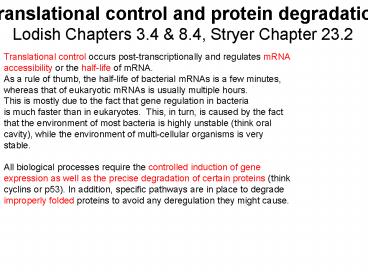Translational control and protein degradation - PowerPoint PPT Presentation
1 / 12
Title:
Translational control and protein degradation
Description:
... or the half-life of mRNA. As a rule of thumb, the half-life of bacterial mRNAs is a few minutes, whereas that of eukaryotic mRNAs is usually multiple hours. ... – PowerPoint PPT presentation
Number of Views:28
Avg rating:3.0/5.0
Title: Translational control and protein degradation
1
Translational control and protein
degradation Lodish Chapters 3.4 8.4, Stryer
Chapter 23.2
Translational control occurs post-transcriptionall
y and regulates mRNA accessibility or the
half-life of mRNA. As a rule of thumb, the
half-life of bacterial mRNAs is a few
minutes, whereas that of eukaryotic mRNAs is
usually multiple hours. This is mostly due to the
fact that gene regulation in bacteria is much
faster than in eukaryotes. This, in turn, is
caused by the fact that the environment of most
bacteria is highly unstable (think oral cavity),
while the environment of multi-cellular organisms
is very stable. All biological processes require
the controlled induction of gene expression as
well as the precise degradation of certain
proteins (think cyclins or p53). In addition,
specific pathways are in place to
degrade improperly folded proteins to avoid any
deregulation they might cause.
2
Different pathways of mRNA degradation
RISC RNA induced silencing
cant bind polyA-binding proteins that
promote interaction with cap
recognizes destabilizing RNA motif
3
RNA-induced silencing
sishort interfering siRNA precursor
23-25 bp
Silencing mRNA degradation
Inhibition of translation
miRNAs and siRNAs have different targets, genes
are often in introns
4
Proteasome- mediated protein degradation
( p53 is usually in a complex with Mdm2, a
ubiquitin ligase, upon phosphorylation by
ATM, Mdm2 is sequestered into the nucleolus)
5
76 aa ( 8kb)
6
(No Transcript)
7
(No Transcript)
8
(No Transcript)
9
Cyclins must be degraded at precise stages during
the cell cycle
Cdc2/Cdk1-cyclin B Cdc2/Cdk1-cyclin A
Cdk4-cyclin D Cdk6-cyclin D
Restriction point is analogous to START
Cdk2-cyclin A
Cdk2-cyclin E
10
Ubiquitin-mediated degradation of mitotic
cyclins promotes exit from mitosis
recognized by E2/E3 complex
11
Velcade (FDA-approved proteasome inhibitor as a
therapy for multiple myeloma plasma cell
myeloma)
12
What you need to know mRNA decay can occur
through RNA silencing (RISC) Decapping Deadenylat
ion Translational inhibition by miRNA/silencing
by siRNA miRNAs and siRNAs are often encoded in
introns. Pre-miRNA forms hairpins, pre-siRNA
forms dsRNA. Both precursors are processed into
short dsRNAs by a protein called dicer. Protein
degradation is mediated by ubiquitin-dependent
degradation (proteasome) and involves E1, E2, E3
enzymes. It occurs in nucleus and cytoplasm.































